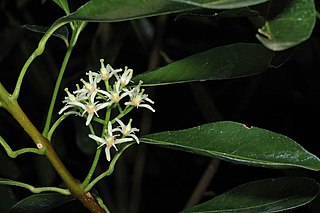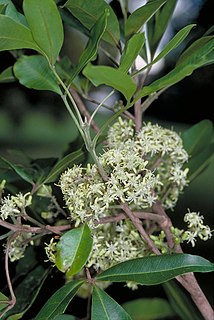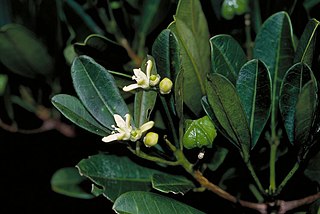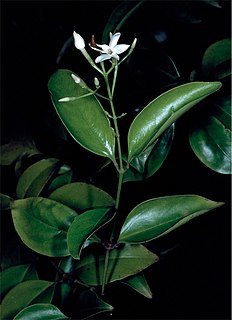
Acronychia oblongifolia, commonly known as white aspen or yellow wood, is a species of shrub to medium-sized rainforest tree of the citrus family, Rutaceae and is endemic to eastern Australia. It has mostly simple, egg-shaped leaves with the narrower end towards the base, small groups of creamy-white flowers and fleshy, more or less spherical, edible fruit.

Acronychia littoralis, commonly known as the scented acronychia, is a species of small tree that is endemic to eastern coastal Australia. It has simple, glabrous, elliptic to egg-shaped leaves, small groups of yellow flowers and egg-shaped to more or less spherical creamy-yellow fruit.

Melicope elleryana, commonly known as pink flowered doughwood, pink evodia, corkwood, or saruwa, is a species of rainforest shrub or tree in the family Rutaceae, and is native to New Guinea, parts of eastern Indonesia, the Solomon Islands and northern Australia. It has trifoliate leaves and pink to white, bisexual flowers arranged in panicles in leaf axils.

Acradenia euodiiformis, commonly known as yellow satinheart or bonewood, is a species of tree that is endemic to eastern Australia. It has mostly trifoliate leaves, the leaflets narrow elliptic to lance-shaped, with prominent oil glands, and panicles of white flowers. It grows in and near rainforest.

Endiandra sieberi, known as the corkwood is a rainforest tree growing in eastern Australia.

Acronychia baeuerlenii, commonly known as Byron Bay acronychia, is a species of rainforest shrub or small tree endemic to eastern Australia. It has simple, glabrous leaves, small groups of flowers and fleshy oval fruit.

Niemeyera whitei known as the rusty plum or plum boxwood is a rare tree of eastern Australia. It occurs on poorer soils in areas below 600 metres above sea level. Found in gully, warm temperate or littoral rainforests. From the Macleay River, New South Wales to Tallebudgera Creek in south eastern Queensland.

Acronychia laevis, commonly known as hard aspen, glossy acronychia or northern white lilly pilly, is a species of shrub or small tree in the citrus family, and is endemic to eastern Australia. It has simple, elliptical to egg-shaped leaves, groups of creamy white flowers and fleshy, mitre-shaped to spherical fruit.

Acronychia octandra, commonly known as doughwood, silver birch or soapwood, is a species of rainforest tree that is endemic to eastern coastal areas of Australia. It has mostly trifoliate leaves with elliptic to egg-shaped leaflets, greenish-white flowers arranged in groups in leaf axils and fleshy fruit of four carpels fused at the base.

Acronychia wilcoxiana, commonly known as silver aspen, doughwood, snowwood or mushyberry, is a species of small rainforest tree that is endemic to eastern Australia. It has simple, elliptical to egg-shaped leaves with the narrower end towards the base, relatively large groups of whitish flowers in leaf axils and broadly oval to more or less spherical, white fruit.

Acronychia pubescens, commonly known as hairy acronychia or hairy aspen, is a species of tall shrub or small tree that is endemic to eastern Australia. It usually has trifoliate leaves, rarely simple leaves, groups of whitish flowers in leaf axils and creamy to yellowish, elliptical to spherical fruit.
Acronychia aberrans, commonly known as acid berry, lemon aspen, plasticine tree or plasticene aspen, is a species of medium-sized rainforest tree that is endemic to north-eastern Queensland. It has simple leaves on stems that are more or less square in cross-section, flowers in small groups in leaf axils and fleshy, more or less spherical fruit.

Acronychia acronychioides, commonly known as white aspen, is a species of small to medium-sized rainforest tree that is endemic to north-eastern Queensland. It has trifoliate leaves with elliptic to egg-shaped leaves on stems that are more or less cylindrical, creamy yellow flowers in large groups in leaf axils and fleshy, pear-shaped or spherical fruit.

Acronychia chooreechillum, commonly known as mountain aspen, is a species of shrub or small rainforest tree that is endemic to north-eastern Queensland. It has mostly trifoliate leaves with elliptic to egg-shaped leaflets on stems that are more or less cylindrical, flowers in small groups in leaf axils and fleshy, egg-shaped or elliptical fruit.

Acronychia crassipetala, commonly known as crater aspen, is a species of small rainforest tree that is endemic to north-eastern Queensland. It has simple, elliptic to egg-shaped leaves on cylindrical stems, flowers in small groups, and fleshy, more or less spherical fruit.

Acronychia imperforata, commonly known as Logan apple, Fraser Island apple, or green tree, is a species of rainforest shrub or small tree that is endemic to north-eastern Australia. It has simple, elliptical to egg-shaped leaves, small groups of yellowish or creamy white flowers and fleshy spherical to oval fruit.

Acronychia parviflora is a species of shrub or small rainforest tree that is endemic to north-eastern Queensland. It has simple, egg-shaped to elliptical leaves, flowers arranged singly or in small groups in leaf axils and fleshy, more or less spherical fruit.

Acronychia pauciflora, commonly known as few-flowered acronychia or soft acronychia, is a species of shrub or small tree that is endemic to eastern Australia. It has simple, egg-shaped leaves with the narrower end towards the base, greenish white flowers arranged in small groups, mostly in leaf axils and fleshy, more or less spherical fruit.

Flindersia acuminata, commonly known as silver silkwood, icewood, Putt's pine, Paddy King's beech or silver maple, is a species of tree that has pinnate leaves with between six and ten egg-shaped to elliptic leaflets, creamy yellow flowers arranged in panicles, and fruit studded with short, rough points.

Melicope vitiflora, commonly known as northern evodia, fishpoison wood, leatherjacket or leatherwood, is a species of shrub or small tree in the family Rutaceae and is native to north-eastern Australia and New Guinea. It has trifoliate leaves and green to white or cream-coloured flowers borne in panicles in leaf axils.





















